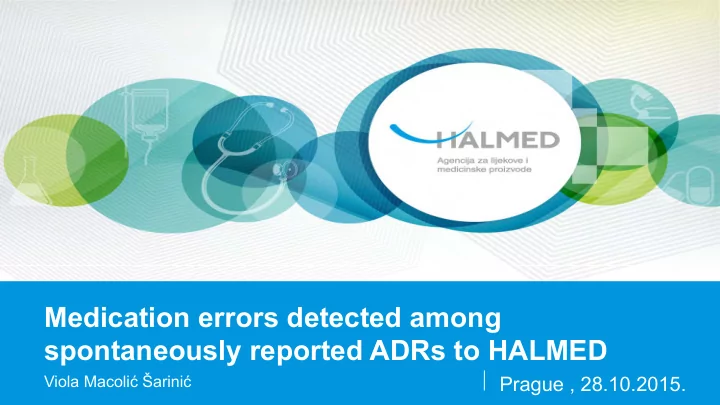

Medication errors detected among spontaneously reported ADRs to HALMED Viola Macoli ć Š arini ć Prague , 28.10.2015.
For public health 2
Aim of the study The objective of the study was to: ü identify, ü evaluate and ü describe medication errors (MEs) among the spontaneously reported ADRs to the Croatian Agency for Medicinal Products and Medical Devices (HALMED). 3
Method ! A retrospective observational study was performed on the first 200 spontaneously reported ADRs in 2013 ! The previously validated “P-method” 1 was employed to systematically detect MEs in individual case safety reports (ICSR) sent to the Croatian Pharmacovigilance Centre (PVC) at HALMED ! ME that lead to ADR identified by reporter as well as ME suspected by assessor are described 1 Soulaymani-Bencheikh R, Khattabi A, Benabdallah G, Alj L, Sefiani H, Hedna K, Ouammi L, Olsson S, Pal SN. Assessment of a new instrument for detecting preventable adverse drug reactions. Drug Saf. 2015 Apr;38(4):383-93 4
Method (cont.) ! Additionally, ME were categorized according to „Good practice guide on recording, coding, reporting and assessment of medication errors”: ! ! medication errors associated with adverse reaction(s), ! ! medication errors without harm, ! ! intercepted medication errors and ! ! potential medication errors 5
Results Number of 45 ME Comorbidities: medicines: 1,6 ± 1,1 with ADRs with ADRs with ADRs with ADRs with ADRs 2,5 ± 1,8 (range 0-6) (range 1-13) 94 ME Gender: Age: 75 M, 125 F 51,7 ± 23,7 (range 8 months to 93 200 ICSRs years) 6
Medication errors • ! Number of ICSR with medication errors associated with adverse reaction according to primary source or according to primary source or according to primary source or according to primary source or according to primary source or ICSRs with ADRs assessor caused by Medication errors (34) ICSRs with ADRs not caused by Medication errors (160) 80% . . 17% Not assessable for Medication errors (6) 3% 26 ICSR = 1 ME with harm 5 ICSR = 2 ME with harm 3 ICSR = 3 ME with harm 7
NUMBER OF ICSR S REPORTED AS SERIOUS VS . NON-SERIOUS ADR S Out of 71 (35,5 %) spontaneously reported serious ADRs, 14 (19,7 %) were caused by medication errors 8
Number of ICSRs with medication errors associated with ADRs according to primary source In Only 3 ICSR out of 34 (9 %) with ADR/ ADRs suspected to be caused by Medication Errors the primary source has clearly stated that a medication error has occurred 9
T HE MOST COMMONLY IDENTIFIED MEDICATION ERRORS The two most commonly identified preventability criteria for ADR occurrence were: • ! “Incorrect dose” 28,3 %; • ! “Documented hypersensitivity to administered drug” reported in 17,4 % of MEs associated with ADRs . Among MEs without harm: • ! “Labelled drug-drug interaction” (32.7%) was the most commonly identified type of ME. 10
THE PERCENTAGE OF MEDICATION ERRORS AMONG THE DIFFERENT MEDICINES 11
Discussion and Conclusion Good practice guide on recording, coding, reporting and assessment of medication errors 12
Discussion and Conclusion (cont.) Good practice guide on recording, coding, reporting and assessment of medication errors 13
Discussion and Conclusion (cont.) ! High number of additional cases should be followed up ! Additional burden to NCAs, MAHs, HCPs # ! Process of identifying ME is very sensitive and relationship between reporter and national pharmacovigilance center should be taken into account ! Not all follow up are sucesfull 1 1 Anton C, Cox AR, Ferner RE. Improving follow-up rates in spontaneous adverse drug reaction reporting: effectiveness of a targeted letter used by a regional centre in the UK. Drug Saf. 2009;32(12):1135-40. 14
Discussion and Conclusion (cont.) Improving number of cases with medication errors associated with adverse reaction reported by primary source: ! Education of reporters ! Improving reporting forms (decision tree) ! Liability for Medication errors by HCPs 15
For safe and effective medicines. www.halmed.hr
Recommend
More recommend